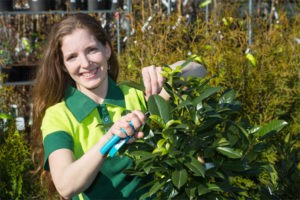
Be on the lookout for yellow plant leaves
What’s going on when you find yellow leaves on the plants in your care? The truth is that there will always be yellow leaves, it’s only natural. There are so many reasons for yellow leaves! Determining the cause and then attempting to stop the problem will lessen the number of yellow leaves you encounter.
Put on your thinking cap
As interior plant technicians, you need to remember that there are a multitude of reasons why plant leaves fall off. Physical injury to a leaf may cause it to turn yellow and drop off. Who knows? Something may have happened while the particular leaf was forming to weaken it. There are also many environmental causes. Dry soil, overly bright lights or cold temperatures can all make leaves turn yellow. Don’t be concerned when a single leaf starts to decline, regardless of its location on the plant. When there are lots of yellow leaves you can begin to be concerned and work at getting to the bottom of the problem.
Light is an important clue because light helps maintain healthy green leaves. This is especially true for those leaves near the base of the plant. There is a tendency for these leaves to be shaded and they may receive only modest light. When this happens, the oldest leaves tend to turn yellow and drop from the plant.
Look around and observe what the lighting is like. Ask questions. Remember you probably see this plant the same time of day week in and week out. What is it like the rest of the day? Are the curtains closed? Open all day?
Light influences the plant’s ability to make food and keep its leaves in good condition. When new leaves appear, older leaves often turn yellow and fall off. This is not unusual because it is how the plant balances available light with the appearance of new leaves. The oldest leaves decline first when there is inadequate “food” to support the entire plant.
A declining root system can also turn leaves yellow. Root injury may occur due to excessive use of fertilizers. High populations of soil insects feeding on the root system can also trigger lower leaves to die.
Too much water in the soil and limited oxygen can also kill the root system. This may happen if there are no drainage holes in the pot. Water may accelerate damage and destroy some or all of the roots. Heavy soils often become waterlogged and roots may die from a lack of oxygen.
If you change the plant’s location it can trigger older leaves to fall off. The plant must adjust to the new environment and in the process it may shed some leaves.
If many leaves turn yellow within a day or two, the plant may have been exposed to cold temperatures and possibly toxic gases. Plants near a window often lose leaves immediately after the first cold spell of the fall. Sometimes propane and natural gas heating systems don’t fire properly and leak gases such as ethylene that can be toxic.
There are no simple answers to the question as to why leaves turn yellow. You must put on our thinking caps, ask questions, become detectives and examine the history, environment, watering and soil conditions in the hope of determining the cause of the problem. Only then can you correct the issue and improve the health of the plant.
